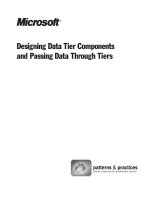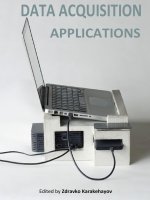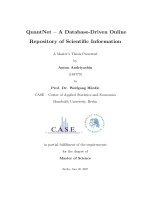Transforming Data into Information pot
Bạn đang xem bản rút gọn của tài liệu. Xem và tải ngay bản đầy đủ của tài liệu tại đây (700.1 KB, 37 trang )
Transforming Data
into Information
lesson 7
This lesson includes the following
sections:
•
How Computers Represent Data
•
How Computers Process Data
•
Factors Affecting Processing Speed
•
Extending the Processor's Power to
Other Devices
•
Binary Numbers
•
The Binary Number System
•
Bits and Bytes
•
Text Codes
How Computers Represent Data
How Computers Represent Data
– Binary Numbers
•
Computer processing is performed by transistors,
which are switches with only two possible states: on
and off.
•
All computer data is converted to a series of binary
numbers– 1 and 0. For example, you see a sentence as
a collection of letters, but the computer sees each
letter as a collection of 1s and 0s.
•
If a transistor is assigned a value of 1, it is on. If it has
a value of 0, it is off. A computer's transistors can be
switched on and off millions of times each second.
Ten different
symbols in
the decimal
system
Numbers above 9
use more than 1 digit
Base 10 Base 2
0 0
1 1
2 10
3 11
4 100
5 101
6 110
7 111
8 1000
9 1001
10 1010
•
To convert data into strings of
numbers, computers use the binary
number system.
•
Humans use the decimal system
(“deci” stands for “ten”).
•
The binary number system works the
same way as the decimal system, but
has only two available symbols (0 and
1) rather than ten (0, 1, 2, 3, 4, 5, 6, 7,
8, and 9).
The Binary Number System
•
A single unit of data is called a bit, having a value of 1
or 0.
•
Computers work with collections of bits, grouping
them to represent larger pieces of data, such as letters
of the alphabet.
•
Eight bits make up one byte. A byte is the amount of
memory needed to store one alphanumeric character.
•
With one byte, the computer can represent one of 256
different symbols or characters.
.
How Computers Represent Data - Bits and Bytes
1 0 1 1 0 0 1 01 0 0 1 0 0 1 01 0 0 1 0 0 1 11 1 1 1 1 1 1 1
•
A text code is a system that uses binary numbers (1s
and 0s) to represent characters understood by humans
(letters and numerals).
•
An early text code system, called EBCDIC, uses eight-
bit codes, but is used primarily in older mainframe
systems.
•
In the most common text-code set, ASCII, each
character consists of eight bits (one byte) of data.
ASCII is used in nearly all personal computers.
•
In the Unicode text-code set, each character consists of
16 bits (two bytes) of data.
How Computers Represent Data - Text Codes
Code Character
00110000 0
00110001 1
00110010 2
00110011 3
00110100 4
00110101 5
01000001 A
01000010 B
01000011 C
01000100 D
01000101 E
Examples from the
ASCII Text Code
Where Processing Occurs:
•
The Control Unit
•
The Arithmetic Logic Unit
•
Machine Cycles
•
The Role of Memory in Processing
•
Types of RAM
How Computers Process Data
•
Processing takes place in the PC's central processing
unit (CPU).
•
The system's memory also plays a crucial role in
processing data.
•
Both the CPU and memory are attached to the
system's motherboard, which connects all the
computer's devices together, enabling them to
communicate.
How Computers Process Data –
Where Processing Occurs
The two main parts of a CPU are the control unit and the
arithmetic logic unit (ALU)
•
The control unit directs the flow of data through the
CPU, and to and from other devices.
•
The control unit stores the CPU's microcode, which
contains the instructions for all the tasks the CPU can
perform.
How Computers Process Data –
The Control Unit
•
The actual manipulation of data takes place in the
ALU.
•
The ALU can perform arithmetic and logic
operations.
•
The ALU is connected to a set of registers—small
memory areas in the CPU, which hold data and
program instructions while they are being processed.
How Computers Process Data –
The Arithmetic Logic Unit
Arithmetic
Operations
Logical
Operations
+ Add
=, ≠ equal to, not equal to
− Subtract
>, > greater than, not greater
than
x Multiply <, < less than, not less than
÷ Divide ≥, ≥ greater than or equal to,
not greater than or equal to
^ Raise by a power
≤, ≤ less than or equal to,
not less than or equal to
ALU Operations List
•
The CPU follows a set of steps-called a machine cycle-
for each instruction it carries out.
•
By using a technique called pipelining, many CPUs can
process more than one instruction at a time.
•
The machine cycle includes two smaller cycles:
During the instruction cycle, the CPU "fetches" a
command or data from memory and "decodes" it for
the CPU.
During the execution cycle, the CPU carries out the
instruction, and may store the instruction's result in
memory.
How Computers Process Data –
Machine Cycles
•
RAM (Random Access Memory) stores data and
program code needed by the CPU. The contents of
RAM change rapidly and often.
•
Read-only memory (ROM) is nonvolatile (or
permanent). It holds instructions that run the
computer when the power is first turned on.
•
The CPU accesses each location in memory by using a
unique number, called the memory address.
How Computers Process Data –
The Role of Memory
There are two basic types of RAM: static and dynamic
•
Dynamic RAM (DRAM) chips must be recharged
with electricity very frequently, or they will lose their
contents. One transistor per bit, slower, cheaper,
larger capacity
•
Static RAM (SRAM) does not need to be recharged
as often as DRAM, and can hold its contents longer.
Another type of RAM, called flash memory, can store its
contents after power is turned off. Flash memory is used
in digital cameras to store pictures.
How Computers Process Data -
Types of RAM
•
Registers
•
RAM
•
The System Clock
•
The Bus
•
Cache Memory
Factors Affecting Processing Speed
•
The CPU contains a number of small memory areas,
called registers, which store data and instructions
while the CPU processes them.
•
The size of the registers (also called word size)
determines the amount of data with which the
computer can work at a one time.
•
Today, most PCs have 32-bit registers, mean the CPU
can process four bytes of data at one time. Register
sizes are rapidly growing to 64 bits.
Factors Affecting Processing Speed – Registers
•
The amount of RAM in a PC has a direct affect on
the system's speed.
•
The more RAM a PC has, the more program
instructions and data can be held in memory, which
is faster than storage on disk.
•
If a PC does not have enough memory to run a
program, it must move data between RAM and the
hard disk frequently. This process, called swapping,
can greatly slow a PC's performance.
Factors Affecting Processing Speed – RAM









